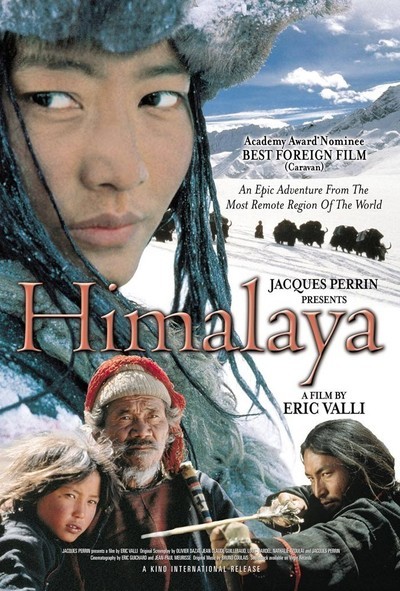HIMALAYA (l’enfance d’un chef)
(director/writer: Eric Valli; screenwriters: Olivier Dazat with the collaboration of Jean-Claude Guillebaud/Louis Gardel/Nathalie Azoulai/Jacques Perrin; cinematographers: Éric Guichard/Jean-Paul Meurisse; cast: Thilen Lhondup (Tinle), Gurgon Kyap (Karma), Lhakpa Tsamchoe (Pema), Karma Wangel (Passang), Karma Tensing (Norbou), Labrang Tundup (Labrang), Tenzen Charka (Chopga), Tsering Dorjee (Rabkie); Runtime: 104; Kino International; 1999)
“A truly magnificent and authentic Nepalese film.”
Reviewed by Dennis Schwartz
A truly magnificent and authentic Nepalese film set in the sparsely populated mountainous region of Dolpo in northwest Nepal. Its appeal is both visually and in its compelling story about the Tibetan villagers who live by their traditions. The filmmaker is the Frenchman Eric Valli, someone who has been interested in Buddhism since childhood and who was a former photographer for National Geographic and has recently been a documentary filmmaker and author. He has lived in Nepal for the last 18 years with his wife and three children. The cast is made up of mostly non-professionals who have not only not acted before, but some have never even seen a film. Their wonderful expressive faces are reflective of the mountains and give the film its very appealing look. Himalaya is noteworthy for its breathtaking shots of mountains that scale as high as 10,000 feet, as Valli daringly shot this almost impossible mountain trek for nine months in all kinds of conditions–including a blinding winter snowstorm. It was shot in Cinemascope using wide-angle panoramic framed shots and was nominated for an Oscar as Best Foreign Film, but lost to Pedro Almodovar’s All About My Mother.
The story in its simplicity can be viewed as a fable about a generational conflict between a stubborn religious traditionalist set in his ways versus the younger man who is influenced by the pragmatism of modern ways and is just as pigheaded as his opponent.
A yak caravan bringing back salt needed to trade for grain returns to the tiny Dolpo mountain village and one of the men on the trek, Karma (Gurgon Kyap), brings back the dead body of the young chief. The chief’s elderly father, Tinle (Thilen Lhondup), who retired so his son could be the caravan leader suspects the ambitious Karma of foul play, even though the two young men were the best of friends. The irritable Tinle is desperate to get someone from his family to lead the next salt-trek across the mountain, a trek that must be done before winter sets in as it’s a matter of survival for the villagers to get food. The dead man’s son, Tsering (Karma Wangiel), is too young to lead the yak caravan and Tinle is too old. He tries to recruit his other son to be the leader, a young man in his twenties, Norbou (Karma Tenzing Nyima Lama). But Norbou has lived in a monastery as a monk since he was 8-years-old and has no skills to lead a caravan, as he has devoted his life to painting and meditation and has studied to be a lama.
The heart of the film begins when Karma refuses to wait for the auspicious date of his trek to be set by the villager’s council of lamas and risks being ostracized for disobeying their traditions. He acts in such haste because he’s worried about winter setting in and impulsively takes some of the younger men with him. Tinle waits for the traditional word from the lamas as the auspicious date is set several days later and he is joined by the superstitious elderly villagers, his dead son’s wife Pema (Lhakpa Tsamchoe) and Tsering, whose name has now been changed to the more humble one of Passang. Norbou also decides to help his father by joining him and when asked why– gives the very Buddhist response he learned from his master: “When two trails open in front of you, Which one do you take?” The answer is “You always take the hardest one,” the implication being that there’s more to learn on that path.
The film becomes in its second half an amazing visual spectacle and a challenge to the filmmaker to record the earnest story in the most difficult of locations, as it follows the two parties through the barren highland valleys and unsafe mountain passes.
It’s a testament to the spirit and courage of these followers of Tibetan culture, who strive to carry on the traditions. It’s ultimately a film about finding out who you are and about living in harmony with nature. I enjoyed it immensely and believe this rare film will be remembered for the simplicity of its very human story and the deep respect it has for a way of life that is endangered. If it wasn’t a more penetrating look at the Nepal villagers and their superstitions and if the drama wasn’t more subtle–so be it! That might be the task of another filmmaker. What this film did was show us a way of life that few have ever witnessed, and it did it in a spirited pictorial manner.

REVIEWED ON 10/9/2001 GRADE: A